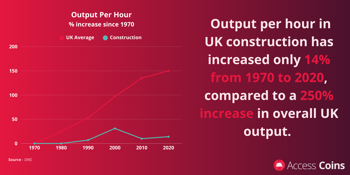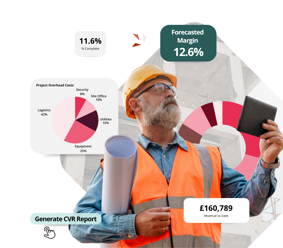The Biggest Challenges in UK Construction in 2025 — and Practical Ways to Tackle Them
Construction output has shown signs of recovery in 2025—but the sector still tops the UK insolvency tables, faces a critical skills gap, and remains off‑track for net zero – with a UK Green Building Council analysis suggesting decarbonisation efforts need to double to reach 2050 targets.
This guide explains the biggest challenges in UK construction and what leaders can do to tackle them.
What Are The Main Challenges In The Construction Industry In 2025?
The Construction Skills Gap
- An ageing skilled workforce, a persistent image problem for younger workers and increasing project complexity has led to a critical construction labour shortage in the UK.
- The UK needs 239,300 additional construction workers by 2029 according to the CITB. Apprenticeship starts are rising slightly but need to triple to meet demand.
The UK construction industry is facing a serious labour crunch, and it’s not just a short-term hiccup. A combination of factors is driving this shortage: an ageing workforce with many skilled professionals nearing retirement, a persistent image problem that makes construction less appealing to younger generations, and the growing complexity of modern projects that demand more specialised skills.
According to the Construction Industry Training Board (CITB), the UK will need an additional 239,300 construction workers by 2029 just to keep up with demand. While there’s been a slight uptick in apprenticeship starts, it’s nowhere near enough — the current rate would need to triple to close the gap. Without a significant shift in how the industry attracts, trains, and retains talent, this shortage could become a major bottleneck for growth and innovation.
What good looks like -
Structured training & career development:
- Continuous learning programs for both new hires and existing staff.
- Clear career pathways, mentorship and leadership training to show progression and retain talent.
- Cross-training employees to handle multiple roles, boosting flexibility and job satisfaction.
Technology as a talent magnet:
- Adopt modern tools like BIM, AI and prefabrication to make roles less labour-intensive and more appealing to tech-minded recruits.
- Use digital platforms for onboarding, competency tracking and safety—showing candidates a forward-thinking workplace.
Try this -
- Use Access Coins, our construction specific ERP, to centralise HR, payroll and project data in one platform—so you can:
- Map skills gaps across live projects and upcoming bids.
- Automate onboarding and competency tracking for new hires and apprentices.
- Schedule training and certifications alongside project timelines, reducing downtime.
- Showcase your tech adoption in recruitment campaigns—highlighting how integrated ERP, digital workflows, and modern tools make jobs safer and more rewarding.
- Pair senior staff with apprentices using Access Coins’ resource planning features to ensure structured knowledge transfer before retirement waves hit.
Learn more about skills shortages in the UK construction industry >

Stagnant Productivity and Slow Digital Adoption
- Construction productivity has flatlined for decades, and the urgency to digitise construction is rising. UK construction output per hour has increased only 14% from 1970 to 2020, compared to a 250% increase in overall UK output.
- The latest RICS Digitalisation in Construction Report found that the sector had confidence in the benefits of AI technology—but face persistent blockers in skills, cost and collaboration.
For decades, productivity in construction has barely budged —between 1970 and 2020, UK construction output per hour increased by just 14%, while overall UK productivity surged by 250%. That gap speaks volumes. One of the biggest culprits? Time lost to inefficiencies. Construction professionals routinely spend hours searching for information, documentation or data buried in disconnected systems. These silos slow down decision-making, increase risk, and make it harder to deliver projects on time and on budget.
The urgency to digitise construction is growing fast. Technology offers immediate productivity gains by streamlining workflows, centralising data and reducing manual effort.
There’s growing optimism in the sector. The latest RICS Digitalisation in Construction report found that professionals are confident in the potential of AI and digital tools to transform how projects are delivered. But persistent blockers remain: a lack of digital skills, high upfront costs, and fragmented collaboration across stakeholders continue to hold back progress.
What good looks like -
- One source of truth for all construction data collected across projects to connect teams.
- Document management and change control with mobile capture and approval workflows.
- AIassisted estimating and forecasting to improve win rates and margins.
Leading firms are standardising processes, integrating data and using AI to cut waste and increase output.
Try this -
A construction-specific ERP like Access Coins brings all of your project data and documentation under one unified platform. Instead of juggling spreadsheets and disconnected tools, teams can work from a single source of truth.
“All of the challenges facing construction today aren’t isolated issues. They’re connected by one thing- data. When project, financial and workforce information lives in silos, leaders simply can’t manage risk, spot blockers or act quickly and decisively. That’s why futureready contractors are moving to integrated platforms like Access Coins.”
— Alex Boury, General Manager, Access Construction

‘Net Zero’ & Sustainability
- The built environment contributes 25% of total UK emissions — and progress toward Net Zero by 2050 is lagging.
- Contractors must accelerate action, especially around retrofit, whole-life carbon and modern construction methods.
The UK’s Net Zero target for 2050 is ambitious — and the construction sector has a central role to play. Right now, the built environment accounts for a quarter of the country’s total emissions, and progress is falling short of the pace needed to meet national goals. Retrofit and whole-life carbon strategies are especially critical, given that 80% of the buildings we’ll be using in 2050 already exist. That means focus is shifting from new builds to upgrading what’s already built.
At the same time, Modern Methods of Construction (MMC) are evolving fast. Panelised and offsite systems are gaining traction, offering opportunities to reduce waste and streamline delivery.
Contractors who can demonstrate capability in these areas — and who can track carbon alongside cost and schedule — will be better positioned to win work, especially in public procurement where whole-life carbon assessments are becoming standard.
What good looks like -
- Whole-life carbon assessments embedded into bid and project workflows.
- Retrofit workstreams built into core capability — not just specialist teams.
- MMC adoption that supports sustainability goals and improves delivery efficiency.
Try this -
- Start tracking embodied and operational carbon at the project level — ideally alongside cost and schedule data.
- Build retrofit work packages and supply chain frameworks that can scale across multiple projects.
- Explore partnerships with MMC providers to expand your delivery options and reduce environmental impact.
Future-Proof your Construction Business with Access Construction Software
Access Construction provides industry-leading construction software to over 1,000 contractors in the UK and Ireland. Our products include the leading construction ERP, Access Coins, and our construction estimating software, Access ConQuest.
Cash Flow Pressure, Delayed Payments and Insolvency Risks
- Construction remains the UK’s most affected sector for insolvencies, often triggered by poor cash flow and unresolved debt.
- Contractors need tighter cash control, better payment discipline and smarter client selection to stay financially resilient.
Cash flow remains one of the biggest pressure points in construction. The sector continues to top UK insolvency charts, with many failures linked to bad debt and delayed payments. While some improvements are being made in payment benchmarking, the reality is that many contractors still face unpredictable income and mounting financial risk. Without disciplined cash management, even profitable businesses can find themselves in trouble.
That’s why weekly forecasting, tighter control over work-in-progress (WIP), and cleaner payment processes are more important than ever. Clear documentation, signed change orders, and timely applications for payment can be lifelines for precarious construction firms.
What good looks like -
- Weekly cash flow forecasting with a rolling 13-week view tied to WIP and billing readiness.
- Strong payment hygiene: clear documentation, signed variations, and accurate applications.
- Client selection based on payment history and reliability — not just contract value.
Try this -
Use Access Coins ERP to generate real‑time cash flow forecasts and CVRs by linking live project costs, committed spend and billing schedules. Access Coins ERP can also be used to apply payment standardisation processes and keep audit trails to reduce the number of payment disputes.

Regulation and Compliance
- UK building regulations are evolving rapidly, with major changes like the Building Safety Act and updates to Part L.
- Contractors need systematic ways to stay compliant, track updates and maintain auditable records across teams and projects.
Regulatory change in UK construction is picking up pace and the compliance landscape is becoming more demanding. The Building Safety Act, strengthened payment reporting and updates to Part L energy efficiency standards have required huge shifts in workflows – with more regulations to come.
Government buyers are also raising the bar. Net zero performance and whole-life carbon are now key criteria in public procurement and property standards. Transparency around payment practices, including retentions, is being strengthened, and failure to comply can mean lost bids or reputational damage. In this environment, relying on ad hoc processes or scattered spreadsheets simply isn’t enough.
What good looks like -
- Centralised compliance tracking across regulations, standards, and project documentation.
- Clear audit trails for payment practices, safety records and sustainability metrics.
- Proactive updates and training workflows to keep teams aligned with evolving requirements.
Try this -
- Use a construction document management system to centralise policies, training records, accreditations, plant maintenance logs and H&S documentation — with automated renewal alerts.
- Assign responsibility for regulatory tracking to a dedicated compliance lead or team.
- Build a regular review cadence into project workflows to catch and act on regulatory changes early.
Health & Safety
- In 2024, UK construction fatalities dropped to 35 — down from 49 in 2023 — but key risks remain.
- Falls from height, moving vehicles, and struck-by incidents are still the leading causes, and digital tools can help reduce them.
While the overall trend of a drop in fatalities is encouraging, construction remains one of the most hazardous industries in the UK. The most common causes of accidents and fatalities - falls, vehicle-related incidents, and being struck by moving objects – can be preventable with the right systems in place. Proactive safety management, supported by digital tools, can help teams identify risks earlier, respond faster and maintain compliance.
What good looks like -
- Continuous competency management with up-to-date training and certifications.
- Real-time hazard reporting via mobile tools to capture and act on issues instantly.
- Automated audit trails for inspections, inductions, and corrective actions.
Try this -
- Use mobile tools to conduct site inspections, capture photo evidence and auto-generate non-conformance reports.
- Set up alerts for expiring certifications and link training records to roles and responsibilities.
- Centralise H&S documentation to ensure quick access during audits or incident reviews.

Future-Proof your Construction Business with Access Coins
Access Coins is a construction specific platform designed to help contractors stay competitive, compliant and profitable in a rapidly changing industry.
- Centralise financial and project data for a single source of truth across every phase of the construction lifecycle.
- Forecast cashflow accurately with real-time visibility of WIP, retentions and committed costs.
- Manage applications for payment, invoicing and credit control to reduce disputes and speed up cash collection.
- Track compliance and competencies alongside project schedules to keep your workforce safe and audit ready.
Ready to see how Access Coins can help you reduce risk and boost margins?
More construction software information, guidance and advice

What Is Cost Value Reconciliation (CVR) In Construction?
Go to article
What Is Job Costing In Construction?
Go to article
Benefits of Using ERP In The Construction Industry – Reviewing The Pros and Cons Of An ERP System
Go to article

 AU & NZ
AU & NZ
 SG
SG
 MY
MY
 US
US
 IE
IE

